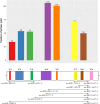A comprehensive fungi-specific 18S rRNA gene sequence primer toolkit suited for diverse research issues and sequencing platforms
- PMID: 30458701
- PMCID: PMC6247509
- DOI: 10.1186/s12866-018-1331-4
A comprehensive fungi-specific 18S rRNA gene sequence primer toolkit suited for diverse research issues and sequencing platforms
Erratum in
-
Correction to: A comprehensive fungi-specific 18S rRNA gene sequence primer toolkit suited for diverse research issues and sequencing platforms.BMC Microbiol. 2019 Nov 8;19(1):249. doi: 10.1186/s12866-019-1628-y. BMC Microbiol. 2019. PMID: 31703615 Free PMC article.
Abstract
Background: Several fungi-specific primers target the 18S rRNA gene sequence, one of the prominent markers for fungal classification. The design of most primers goes back to the last decades. Since then, the number of sequences in public databases increased leading to the discovery of new fungal groups and changes in fungal taxonomy. However, no reevaluation of primers was carried out and relevant information on most primers is missing. With this study, we aimed to develop an 18S rRNA gene sequence primer toolkit allowing an easy selection of the best primer pair appropriate for different sequencing platforms, research aims (biodiversity assessment versus isolate classification) and target groups.
Results: We performed an intensive literature research, reshuffled existing primers into new pairs, designed new Illumina-primers, and annealing blocking oligonucleotides. A final number of 439 primer pairs were subjected to in silico PCRs. Best primer pairs were selected and experimentally tested. The most promising primer pair with a small amplicon size, nu-SSU-1333-5'/nu-SSU-1647-3' (FF390/FR-1), was successful in describing fungal communities by Illumina sequencing. Results were confirmed by a simultaneous metagenomics and eukaryote-specific primer approach. Co-amplification occurred in all sample types but was effectively reduced by blocking oligonucleotides.
Conclusions: The compiled data revealed the presence of an enormous diversity of fungal 18S rRNA gene primer pairs in terms of fungal coverage, phylum spectrum and co-amplification. Therefore, the primer pair has to be carefully selected to fulfill the requirements of the individual research projects. The presented primer toolkit offers comprehensive lists of 164 primers, 439 primer combinations, 4 blocking oligonucleotides, and top primer pairs holding all relevant information including primer's characteristics and performance to facilitate primer pair selection.
Keywords: 18S rRNA gene sequence (SSU) primer; Annealing blocking oligonucleotides; Co-amplification; Community survey; FF390; FR-1; Fungal biodiversity; Fungi; Real-time Q-PCR; Taxonomic classification.
Conflict of interest statement
Ethics approval and consent to participate
Not applicable.
Consent for publication
Not applicable.
Competing interests
The authors declare that they have no competing interests.
Publisher’s Note
Springer Nature remains neutral with regard to jurisdictional claims in published maps and institutional affiliations.
Figures



References
-
- Nilsson RH, Wurzbacher C, Bahram M, Coimbra VRM, Larsson E, Tedersoo L, et al. Top 50 most wanted fungi. Mycokeys. 2016;12:29–40. doi: 10.3897/mycokeys.12.7553. - DOI
Publication types
MeSH terms
Substances
LinkOut - more resources
Full Text Sources
Research Materials

